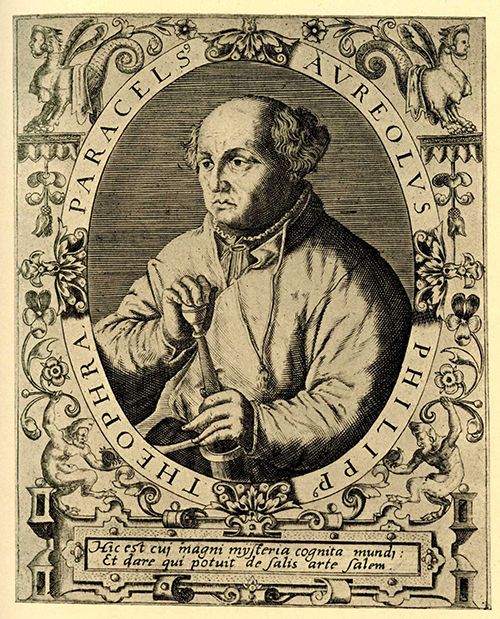Labyrinthus medicorum errantium…Cum adjunctis. Nuremberg: V. Neuber, 1553. Bound with his Modus pharmacandi, Für pestilentz, Baderbüchlin, and Spittal büch.
 It was not until the Renaissance that the study of medicine began to break from the strict authority of Galenic tradition. One of the first to do this was Philippus Aureolus Theophrastus Bombastus von Hohenheim, who named himself for all posterity as Paracelsus, suggesting that he was equal or superior to the ideas of the Roman medical writer Celsus. Born near Zurich, Switzerland, he learned medicine, science and natural philosophy from his physician father, and from the churchmen of the surrounding countryside, he learned about the occult, astrology and alchemy. He received a medical degree from the University of Ferrara where he came to respect the observation-based medicine of Hippocrates. Then he traveled all over Europe, fraternizing with barber-surgeons, executioners, midwives, gypsies and fortune-tellers where he acquired knowledge of folk medicine (Garrison 204). Combined together, these divergent modes of thought helped create the inventive but abrasive personality of Paracelsus.
It was not until the Renaissance that the study of medicine began to break from the strict authority of Galenic tradition. One of the first to do this was Philippus Aureolus Theophrastus Bombastus von Hohenheim, who named himself for all posterity as Paracelsus, suggesting that he was equal or superior to the ideas of the Roman medical writer Celsus. Born near Zurich, Switzerland, he learned medicine, science and natural philosophy from his physician father, and from the churchmen of the surrounding countryside, he learned about the occult, astrology and alchemy. He received a medical degree from the University of Ferrara where he came to respect the observation-based medicine of Hippocrates. Then he traveled all over Europe, fraternizing with barber-surgeons, executioners, midwives, gypsies and fortune-tellers where he acquired knowledge of folk medicine (Garrison 204). Combined together, these divergent modes of thought helped create the inventive but abrasive personality of Paracelsus.
Though his works are filled with references to the occult, mysticism and lore, Paracelsus did contribute significantly to the field of scientific medicine as he attempted to overthrow tradition and find real causes and cures for disease. He was in extreme opposition to the dominance of Galenic doctrine, and while teaching in Basel he publicly burned the writings of Galen and Avicenna, acquiring the name of “Luther of Medicine” (One Hund. Books16). One of Paracelsus’s most important contributions to the field of medicine was to replace the traditional concept of disease as an imbalance of the four humors with the notion of so-called “acrimonies.” Paracelsus’s rejection of Galenic theory of disease causation spurred on his investigation of other forms of therapy, leading him to propose mineral and chemical therapeutics. He also fought the idea that surgery was an inferior branch of medicine, a concept that had begun with Avicenna’s writings. He wrote a clinical account of mental illnesses, which were formerly considered demonic, and advocated humane treatment of these sufferers.
The Reynolds-Finley Library has a volume of five important Paracelsian works bound together. The spine reads Varia, and it includes the famous 1553 work, Labryinthus medicorum errantium, or “The labyrinth of physicians”, in which Paracelsus attacks the academic physicians of his time (Heirs of Hippocrates 119). It also includes a work on medication, Modus pharmacandi (1562), one on hospitals, Spittal Büch (1562), one describing the plague, Für Pestilentz (1554), and Baderbüchlin (1562), a book on baths.
Cambridge. Illus. Hist. Med., pp. 248, 250, 252; Clendening, Source Book of Med. Hist., p. 95; Garrison, Hist. Med.,4th Edition, pp. 203-207; Garrison & Morton, Med. Bib., 5th Edition, 4916.1 & 1818; Heirs of Hippocrates, 116-125; One Hund. Books, 16; Reynolds Historical Library,Rare books and coll…, 3236, 3239-3241, 3243; A catal. of printed books in the Wellcome Hist. Med. Libr., Vol. I, pp. 251-256; Writ. of Paracelsus in the Reynolds Historical Library.
Image: Paracelsus [from]: Guerini, Vincenzo. A history of dentistry from the most ancient times until the end of the eighteenth century. Philadelphia & New York: Lea & Febiger, 1909.
